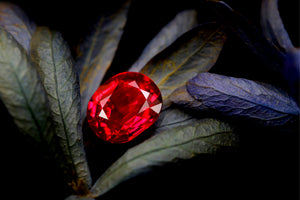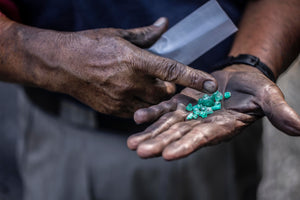Understanding Diamond Fluorescence
By definition, Fluorescence in diamonds refers to the glow they emit, often blue, when subjected to ultraviolet (UV) light.
The rising trend for "triple-excellent/none" (meaning Excellent Cut, Symmetry, & Polish) diamonds might make one think there's been a recent shift. Let's explore what this means in the world of diamonds.
What Causes Fluorescence?
Diamond fluorescence is often caused by nitrogen and boron—nitrogen induces a yellow hue, while boron gives diamonds a blue color. Many natural diamonds contain microscopic amounts of these elements, invisible to the naked eye but detectable under UV light.
The GIA's Take on Fluorescence
The Gemological Institute of America (GIA) introduced fluorescence grading in 1997.
The intensity of this glow is categorized from None to Very Strong. While 25% to 35% of diamonds analyzed by GIA show some fluorescence, only about 10% demonstrate an intensity that could alter the stone's appearance, often resulting in a milky or hazy look.
Do Lab Grown Diamonds Have Fluorescence?
Lab-grown diamonds are cultivated in controlled conditions using specific methods, usually exhibit no fluorescence. Any fluorescence present is typically treated and eliminated before these diamonds reach the market, ensuring their purity and appeal."

Fluorescence's Impact on Diamond Quality
The mere presence of fluorescence doesn't inherently affect a diamond's quality.
If fluorescence introduces visible flaws, like a "milky" appearance, these are noted by the GIA as separate from the fluorescence grade.
The main difference between fluorescent and non-fluorescent diamonds now boils down to price. With a higher demand for non-fluorescent stones, diamonds with fluorescence are priced more affordably, offering an attractive option for buyers.
Remember, fluorescence is just one aspect of a diamond's overall charm.
Making an Informed Decision
Before opting for a non-fluorescent diamond at a premium price, consider how often you'll encounter conditions where fluorescence is visible.
UV light exposure is relatively rare in everyday settings. Whether your diamond has fluorescence or not, its true beauty and value are not solely defined by this single feature.
It's crucial to weigh all factors and make a choice that aligns with your preferences and lifestyle.
The practical perspective: Why Should You Care?
Unless a diamonds fluorescence effects the naked eye optics of the diamond, as a consumer, you should not be concerned with the fluorescence grading.
Sometimes, high fluorescence diamonds have a “milkiness” to them that are visible to the naked eye without exposure too UV light. In a case like this, you should pay attention to how the fluorescence grading relates to the price.







